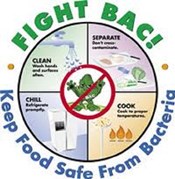Over the years we have all heard advice related to food safety. Some of this advice rings true, while other guidance is just plain wrong.
Test your food safety knowledge by answering the following true or false food safety questions.
1. Microwaving food kills bacteria so the food is safe to eat.
False: Microwaves aren’t what kill bacteria – it’s the heat generated by microwaves that kills bacteria in foods. Microwave ovens are great time-savers and will kill bacteria in foods when heated to a safe internal temperature. However, foods can cook unevenly because they may be shaped irregularly or vary in thickness. Even microwave ovens equipped with a turntable can cook unevenly and leave cold spots in food, where harmful bacteria can survive. Be sure to follow package instructions and rotate and stir foods during the cooking process, if the instructions call for it. Observe any stand times as called for in the directions. Check the temperature of microwaved foods with a food thermometer in several spots.
2. You need to wash produce even if you are going to peel it.
True: You should wash fresh fruits and vegetables under running tap water just before eating, cutting or cooking. Harmful bacteria could be on the outside of the produce. If you peel or cut it without first washing it the bacteria could be transferred to the part you eat. Wash delicate produce such as grapes or lettuce under cool running water. Blot dry with a clean cloth towel or paper towel. Rub firm-skin fruits and vegetables under running tap water or scrub with a clean produce brush. Never use detergent or bleach to wash fresh fruits or vegetables. These products are not intended for consumption.
3. You need to wash all bagged lettuce and greens.
False: While it is important to thoroughly wash most fresh fruits and vegetables, if packaged greens are labeled “ready-to-eat”, “washed” pr “triple washed” then the product does NOT need to be washed at home. Pre-washed greens have been through a cleaning process immediately before going into the bag. Re-washing and handling the greens creates opportunities for contamination.
4. You can re-freeze foods after you have thawed them – you don’t have to cook them or throw them away.
True: If raw foods such as meat, poultry, egg products, and seafood have been thawed in the refrigerator, then they may be safely re-frozen without cooking for later use. Never thaw foods by letting them sit on the kitchen counter. If raw foods are thawed outside of the refrigerator, for example in the microwave or in cold water, they should be cooked immediately. Never re-freeze raw or not fully cooked foods that have been thawed outside of the refrigerator.
5. Putting chicken in a colander and rinsing it with water will remove bacteria like salmonella.
False: Rinsing poultry in a colander will not remove bacteria. In fact, it can spread raw juices around your sink, onto your countertops, and onto ready-to-eat foods. Bacteria in raw meat and poultry can only be killed when cooked to a safe internal temperature, which for poultry is 165° F, as measured with a food thermometer. Save yourself the messiness of rinsing raw poultry. It is not a safety step and can cause cross-contamination!
6. You should not put hot food in the refrigerator.
False: Hot food can be placed directly in the refrigerator. A large pot of food like soup or stew should be divided into small portions and put in shallow containers for quicker cooling in the refrigerator. If you leave food out to cool and forget about it then toss it! Food is not safe to eat after sitting out at room temperature for more than two hours. Bacteria grow rapidly in the "danger zone" between 40° F & 140° F. Always follow the “two hour rule” – refrigerate perishable foods within two hours at a refrigerator temperature of 40° F or below. And if left out in a room or outdoors where the temperature is 90° F or hotter, food should be refrigerated or discarded within just 1 hour.
7. Once a hamburger turns brown in the middle it is cooked.
False: You cannot use visual cues to determine whether food has been cooked to a safe internal temperature. The ONLY way to know that food has been cooked to a safe internal temperature is to use a food thermometer. Ground meat should be cooked to a minimum internal temperature of 160° F, as measured by a food thermometer. One in four hamburgers turn brown in the middle before reaching the safe temperature of 160° F.







